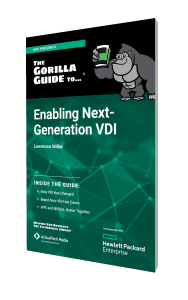New Release: The Gorilla Guide To…® Enabling Next-Generation VDI

Ever since the advent of the personal computer (PC) in the early 1980s, companies have been struggling to serve and control their employers computers. The PC was great for productivity and creativity, but it opened a Pandora’s box of dangers: poorly designed applications, malware, data that became lost or corrupted on an individual’s computer, and time-wasting distractions for employees. The same mix of wonderful potential and daunting risks was repeated with the introduction of Software as a Service (SaaS) and again with mobile devices.
Virtual desktop infrastructure (VDI) is today’s solution to providing consistent, powerful functionality to employees while controlling risks. With VDI, an employee logs into a system that looks and behaves like a local computer, but that serves up applications and stores data on the company’s servers or in the cloud. Thus, the company can make sure that every user gets the software they need, that the applications are up-to-date and free of malicious exploits, that the view and experience is the same across different devices, and that the user’s data is automatically backed up.
In many ways, VDI is an extension of SaaS. Your company can benefit from VDI because you probably use applications that don’t have SaaS offerings. You can load these applications on a server and offer them to users without requiring each user to load and maintain the application and its data on their personal computer or mobile device.
The problems with VDI are the extra overhead it imposes on graphical performance and on the network. Graphical performance is solved through NVIDIA virtualization (see Figure 1), which is used by Hewlett Packard Enterprise (HPE) systems to provide graphical performance comparable to applications running on local systems. Fast networking is becoming supported more and more widely nowadays, particularly with the roll-out of 5G cellular networking.

Enabling Next-Generation VDI explains uses for VDI in several verticals—healthcare, financial services, state and local education, government, manufacturing, media and entertainment, oil and gas, and architecture, engineering, and construction—along with HPE solutions. The report represents an overview of modern virtual services.
Inside the Guide
Gorilla Guides make learning and discovery approachable and easy, and they take the guesswork out of navigating complicated IT technologies. Written by an industry expert, and brought to you by Hewlett Packard Enterprise, this resource is packed full of trusted information about the value of NVIDIA virtualization for high-performance VDI!
Download the book and learn all about:
- The Role of Virtual Desktop Infrastructure (VDI) in Modern Enterprises
- How Various Industries Can Use VDI
- The Architecture of Systems and Racks Offered by HPE
Table of Contents
Introduction: This Is Not Your Father’s VDI
Chapter 1: Why VDI Is the Right Solution for Remote
- Work Environments
- Security
- Mobility
- User Experience and Performance
- Manageability
- VDI Across Industries
Chapter 2: New Opportunities for VDI in the Modern Workplace
- Healthcare
- Financial Services Industry
- State and Local Education
- Government
Chapter 3: Evolving Beyond Traditional VDI for Creative and Technical Professionals
- Manufacturing
- Media and Entertainment (M&E)
- Oil and Gas (O&G)
- Architecture, Engineering, and Construction (AEC)
Chapter 4: The HPE and NVIDIA Difference
- Platform Choice
- Consumption-Based Models
- Validated Designs and Reference Architectures
- Deployment Services
- Accelerated Performance with HPE and NVIDIA
Download Your Copy!
About the Author
Lawrence Miller, CISSP, has worked in information security and technology management for more than 25 years. He has previously worked as the Vice President of IT for a major Verizon reseller, director of IT and e-commerce for a retail merchandising company, and IT operations manager for a top 100 U.S. law firm. He is the author of more than 200 books on various topics including information security, cloud, unified communications and collaboration, storage, 5G, and the Internet of Things.
About Hewlett Packard Enterprise
Hewlett Packard Enterprise is the global edge-to-cloud platform-as-a-service company that helps organizations accelerate outcomes by unlocking value from all of their data, everywhere. Built on decades of reimagining the future and innovating to advance the way we live and work, HPE delivers unique, open and intelligent technology solutions, with a consistent experience across all clouds and edges, to help customers develop new business models, engage in new ways, and increase operational performance. For more information, visit: www.hpe.com.